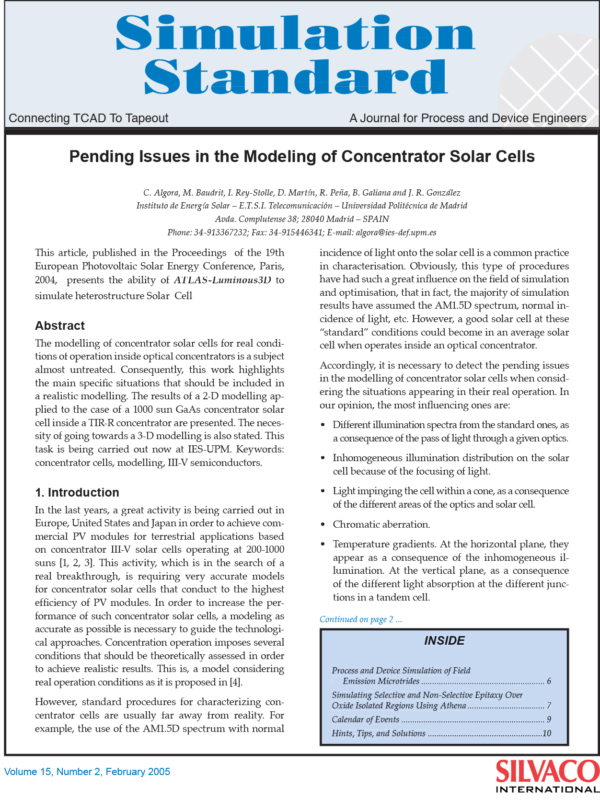Pending Issues in the Modeling of Concentrator Solar Cells
C. Algora, M. Baudrit, I. Rey-Stolle, D. Martín, R. Peña, B. Galiana and J. R. GonzálezInstituto de Energía Solar – E.T.S.I. Telecomunicación – Universidad Politécnica de MadridAvda. Complutense 38; 28040 Madrid – SPAINPhone: 34-913367232; Fax: 34-915446341; E-mail: algora@ies-def.upm.es
This article, published in the Proceedings of the 19th European Photovoltaic Solar Energy Conference, Paris, 2004, presents the ability of ATLAS-Luminous3D to simulate heterostructure Solar Cell
Abstract
The modelling of concentrator solar cells for real conditions of operation inside optical concentrators is a subject almost untreated. Consequently, this work highlights the main specific situations that should be included in a realistic modelling. The results of a 2-D modelling applied to the case of a 1000 sun GaAs concentrator solar cell inside a TIR-R concentrator are presented. The necessity of going towards a 3-D modelling is also stated. This task is being carried out now at IES-UPM. Keywords: concentrator cells, modelling, III-V semiconductors.
Introduction
In the last years, a great activity is being carried out in Europe, United States and Japan in order to achieve commercial PV modules for terrestrial applications based on concentrator III-V solar cells operating at 200-1000 suns [1, 2, 3]. This activity, which is in the search of a real breakthrough, is requiring very accurate models for concentrator solar cells that conduct to the highest efficiency of PV modules. In order to increase the performance of such concentrator solar cells, a modeling as accurate as possible is necessary to guide the technological approaches. Concentration operation imposes several conditions that should be theoretically assessed in order to achieve realistic results. This is, a model considering real operation conditions as it is proposed in [4].
However, standard procedures for characterizing concentrator cells are usually far away from reality. For example, the use of the AM1.5D spectrum with normal incidence of light onto the solar cell is a common practice in characterisation. Obviously, this type of procedures have had such a great influence on the field of simulation and optimisation, that in fact, the majority of simulation results have assumed the AM1.5D spectrum, normal incidence of light, etc. However, a good solar cell at these “standard” conditions could become in an average solar cell when operates inside an optical concentrator.



